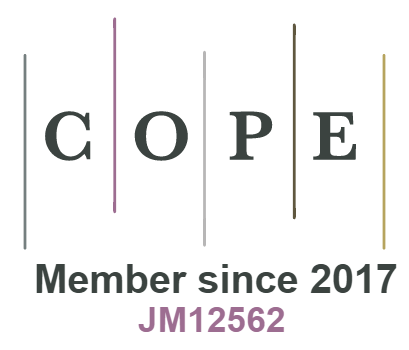Effect of Boric Acid on the Properties of Sorbitol Plasticized Starch/PVA Blends
DOI:
https://doi.org/10.18034/ei.v5i2.179Keywords:
Biocomposite, Biodegradation, Pregelatinized Maize Starch, PVAAbstract
This research aimed to focus on the thermochemical and physico-mechanical properties along with biodegradability nature of partially pregelatinized maize starch (PMS) and polyvinyl alcohol (PVA) based biocomposites. Several PMS/PVA/BA (varying the mass ratio, wt %) based biocomposites were prepared by solution casting with and without sorbitol plasticizer. Boric acid (BA) used as cross linked agent. The FT-IR, DSC and TGA results revealed that the hydrogen bonding takes place between PMS and PVA in presence of BA and thus biocomposites shown more thermal stability than that of pure PMS and PVA provided by TGA and DSC. Based on the results, sorbitol plasticized PMS/PVA/BA (5%) was optimized as pliable and stable biocomposite; the tensile strength (TS)and percentage of elongation at break (EB%) was 16.6 MPa and 11.2 % respectively. However, unplasticized biocomposites shown the highest TS (38.1 MPa) but were hard and brittle. Moreover, the optimized biocomposite was the lower moisture sensitivity and moderate water solubility compared to other biocomposites. In addition, the biodegradability nature of biocomposites were also investigated and found it biodegradable. Thus, the optimized biocomposite (PMS: PVA: BA with a ratio of 40:55:5) can be used as effective and eco-friendly packaging material.
Downloads
References
Babaee, M., Jonoobi, M., Hamzeh, Y., & Ashori, A. (2015). Biodegradability and mechanical properties of reinforced starch nanocomposites using cellulose nanofibers. Carbohydrate polymers, 132, 1-8.
Balakrishnan, P., Sreekala, M. S., Kunaver, M., Huskić, M., & Thomas, S. (2017). Morphology, transport characteristics and viscoelastic polymer chain confinement in nanocomposites based on thermoplastic potato starch and cellulose nanofibers from pineapple leaf. Carbohydrate Polymers, 169, 176-188.
Belgacem, M. N., & Gandini, A. (Eds.). (2011). Monomers, polymers and composites from renewable resources. Elsevier.
Cao, X., Chen, Y., P. R., & Huneault, M. A (2007). Preparation and properties of plasticized starch/multiwalled carbon nanotubes composites. Journal of Applied Polymer Science, 106(2), 1431-1437.
Chen, N., Li, L., & Wang, Q. (2007). New technology for thermal processing of poly (vinyl alcohol). Plastics, Rubber and Composites, 36(7-8), 283-290.
Chen, Y., Cao, X., Chang, P. R., & Huneault, M. A (2008). Comparative study on the films of poly (vinyl alcohol)/pea starch nanocrystals and poly (vinyl alcohol)/native pea starch. Carbohydrate Polymers, 73, 8–17.
Gohil, J. M., Bhattacharya, A., & Ray, P. (2006). Studies on the crosslinking of poly (vinyl alcohol). Journal of polymer research, 13(2), 161-169.
Harun‐or‐Rashid MD, Rahaman S, Enamul Kabir S, Khan MA (2016). Effect of hydrochloric acid on the properties of biodegradable packaging materials of carboxymethylcellulose/poly (vinyl alcohol) blends. Journal of Applied Polymer Science, 133(2).
Krumova, M. Lopez, D., R., Mijangos, C., Perena, J.M (2000). Effect of crosslinking on the mechanical and thermal properties of poly (vinyl alcohol). Polymer, 41, 9265-9271.
Maria Rapa, Elena Gruso, Petruta Stoica, Mihaela Andreica (2014). Polyvinyl alcohol and starch blends: properties and biodegradation behavior. Journal of Environmental and Research Protection, Volume 11, Issue 1.
Martelli S. M., Geovana M., Paes S. S., Cristhiane G. Jo~ao, B. L (2006). LWT—Food Sci.Technol, 39,292.
Martins, M. G. I., Magina, S. P., Oliveira, L., Freire, C. S. R., Silvestre, A. J. D., Neto, C.P., et al (2009). New biocomposites based on thermoplastic starch and bacterial cellulose. Composites Science and Technology, 69(13), 2163–2168.
Muller, R.J.; Witt, U.; Rantze, E.; Deckwer, W.D (1998). Architecture of biodegradable copolyesters containing aromatic constituents. Polym. Degrad, 59, 203-208.
Noshirvani, N., Ghanbarzadeh, B., Fasihi, H., & Almasi, H. (2016). Starch–PVA nanocomposite film incorporated with cellulose nanocrystals and MMT: a comparative study. International journal of food engineering, 12(1), 37-48.
Savadekar, N. R., & Mhaske, S. T (2012). Synthesis of nano cellulose fibers and effect on thermoplastics starch based films. Carbohydrate Polymers, 89(1), 146–151.
Spinella, S., Maiorana, A., Qian, Q., Dawson, N. J., Hepworth, V., McCallum, S. A., & Gross, R. A. (2016). Concurrent cellulose hydrolysis and esterification to prepare a surface-modified cellulose nanocrystal decorated with carboxylic acid moieties. ACS Sustainable Chemistry & Engineering, 4(3), 1538-1550.
Sreedhar, B., Chattopadhyay, D.K., Karunakar, M.S.H., & Sastry, A.R.K (2006). Thermal and surface characterization of plasticized starch polyvinyl alcohol blends crosslinked with epichlorohydrin. Journal of Applied Polymer Science, 101, 25-34.
Sreedhar, B., Sairam, M., Chattopadhyay, D. K., Rathnam, P. A., & Rao, D. V. (2005). Thermal, mechanical, and surface characterization of starch–poly (vinyl alcohol) blends and borax‐crosslinked films. Journal of Applied Polymer Science, 96(4), 1313-1322.
Sucaldito, M. R., & Camacho, D. H. (2017). Characteristics of unique HBr-hydrolyzed cellulose nanocrystals from freshwater green algae (Cladophora rupestris) and its reinforcement in starch-based film. Carbohydrate Polymers, 169, 315-323.
Tudorachi, N., Cascaval, C. N., Rusu, M., & Pruteanu, M. (2000). Testing of polyvinyl alcohol and starch mixtures as biodegradable polymeric materials. Polymer Testing, 19(7), 785-799.
Wolkers, W. F., Oliver, A. E., Tablin, F., & Crowe, J. H. (2004). A Fourier-transform infrared spectroscopy study of sugar glasses. Carbohydrate research, 339(6), 1077-1085.
Yin, Y., Li, J., Liu, Y., & Li, Z. (2005). Starch cross linked with poly (vinyl alcohol) by boric acid. Journal of Applied Polymer Science, 96(4), 1394-1397.
Yoon, S.D., Chough, S.H., & Park, H.R (2006a). Properties of starch-based blend films using citric acid as additive. Journal of Applied Polymer Science, 100, 2554-2560.
Zhou, X. Y., Jia, D. M., Cui, Y. F., & Xie, D. (2009). Kinetics analysis of thermal degradation reaction of PVA and PVA/starch blends. Journal of Reinforced Plastics and Composites, 28(22), 2771-2780.
--0--
Published
Issue
Section
License
Engineering International is an Open Access journal. Authors who publish with this journal agree to the following terms:
- Authors retain copyright and grant the journal the right of first publication with the work simultaneously licensed under a CC BY-NC 4.0 International License that allows others to share the work with an acknowledgment of the work's authorship and initial publication in this journal.
- Authors are able to enter into separate, additional contractual arrangements for the non-exclusive distribution of the journal's published version of their work (e.g., post it to an institutional repository or publish it in a book), with an acknowledgment of its initial publication in this journal. We require authors to inform us of any instances of re-publication.









